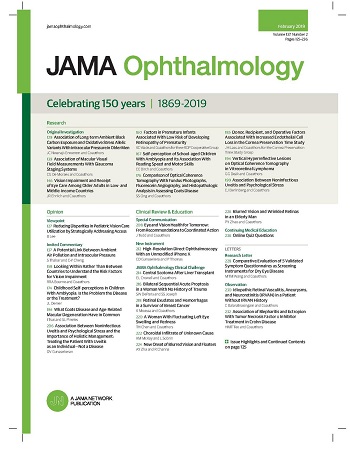Detection and Characterization of RB1 Mosaicism in Patients With Retinoblastoma Receiving cfDNA Test.
IF 7.8
1区 医学
Q1 OPHTHALMOLOGY
引用次数: 0
Abstract
Importance Plasma cell-free DNA (cfDNA) testing is increasingly used for disease diagnosis and monitoring in retinoblastoma, with RB1 allele fraction in cfDNA actively corresponding to disease status and treatment response. However, while RB1 mosaicism has been reported in retinoblastoma, its clinical implications and potential impact on cfDNA testing remain unclear. Objectives To identify RB1 mosaicism using paired plasma and buffy coat (containing lymphocytes, monocytes, granulocytes, and platelets) DNA testing, and to characterize the implications of RB1 mosaicism on cfDNA testing outcomes. Design, Setting, and Participants In this cross-sectional study, participants with retinoblastoma underwent testing with MSK-ACCESS (Memorial Sloan Kettering-Analysis of Circulating cfDNA to Examine Somatic Status), a clinical assay that combines plasma cfDNA and buffy coat genomic DNA sequencing, enabling the detection and differentiation of somatic, heterozygous, and mosaic variants, between July 2020 and April 2024 at the Memorial Sloan Kettering Cancer Center. Mosaic findings from MSK-ACCESS were correlated with those from a subgroup of patients who concurrently underwent testing using the MSK-IMPACT germline assay. Data analysis was performed from April to September 2024. Exposure RB1 mosaicism in retinoblastoma. Main Outcomes and Measures The RB1 variant allele fractions in cfDNA and buffy coat genomic DNA were used to detect RB1 mosaicism. Results A total of 136 consecutive patients with retinoblastoma (median age at diagnosis, 1.0 year [IQR, 0.4-1.7 years]; 74 [54.4%] female; 67 with bilateral disease and 69 with unilateral disease) who underwent testing with the MSK-ACCESS assay were included. RB1 mosaicism was identified in buffy coat DNA from 20 patients (14.7%), with consistent results detected in all 11 participants tested concurrently by the MSK-IMPACT (Memorial Sloan Kettering-Integrated Mutation Profiling of Actionable Cancer Targets) germline assay. Four participants with RB1 mosaicism previously tested negative for germline RB1 variants by external laboratories. Compared with heterozygous participants, participants with RB1 mosaicism had a lower risk of developing bilateral disease (91.7% vs 55.0%, respectively; difference, 36.7% [95% CI, 13.8%-59.6%]; P = .002). In cfDNA, the mosaicism variant was detected both before and after treatment, with variant allele fraction initially decreasing after treatment but then stabilizing at levels consistent with mosaicism, despite the absence of clinical disease. Conclusions and Relevance The accurate detection and quantification of RB1 mosaicism are crucial. RB1 mosaicism should be considered when RB1 variants persist in cfDNA after treatment without evidence of disease; failure to do so may lead to false-positive results and overtreatment in patients with RB1 mosaicism. Identifying RB1 mosaicism may improve patient counseling, inform treatment decisions, and enhance surveillance efforts.接受cfDNA检测的视网膜母细胞瘤患者RB1嵌合体的检测和表征。
血浆游离DNA (cfDNA)检测越来越多地用于视网膜母细胞瘤的疾病诊断和监测,cfDNA中RB1等位基因分数与疾病状态和治疗反应积极对应。然而,尽管RB1嵌合现象在视网膜母细胞瘤中有报道,但其临床意义和对cfDNA检测的潜在影响尚不清楚。目的通过配对血浆和黄皮毛(含淋巴细胞、单核细胞、粒细胞和血小板)DNA检测来鉴定RB1嵌合性,并表征RB1嵌合性对cfDNA检测结果的影响。设计、设置和参与者在这项横剖面研究中,视网膜母细胞瘤患者在2020年7月至2024年4月期间在纪念斯隆·凯特琳癌症中心接受了MSK-ACCESS(纪念斯隆·凯特琳-循环cfDNA分析以检查体细胞状态)的测试,这是一项结合血浆cfDNA和黄毛基因组DNA测序的临床试验,能够检测和分化体细胞、杂合和嵌合变异。来自MSK-ACCESS的马赛克结果与同时接受MSK-IMPACT种系检测的患者亚组的结果相关。数据分析时间为2024年4月至9月。视网膜母细胞瘤中的暴露erb1嵌合现象。利用cfDNA和褐毛基因组DNA中的RB1变异等位基因片段检测RB1嵌合现象。结果共136例视网膜母细胞瘤患者(诊断时中位年龄1.0岁[IQR, 0.4-1.7岁];女性74人[54.4%];67例双侧疾病患者和69例单侧疾病患者接受了MSK-ACCESS检测。在20名患者(14.7%)的黄外套DNA中发现了RB1嵌合现象,同时通过MSK-IMPACT (Memorial Sloan - Kettering-Integrated Mutation Profiling of Actionable Cancer Targets)种系测定,在所有11名参与者中检测到一致的结果。四名RB1嵌合的参与者先前在外部实验室检测出生殖系RB1变异呈阴性。与杂合子受试者相比,RB1嵌合的受试者患双侧疾病的风险较低(分别为91.7%对55.0%;差异为36.7% [95% CI, 13.8% ~ 59.6%];p = .002)。在cfDNA中,嵌合体变异在治疗前后都被检测到,尽管没有临床疾病,但变异等位基因分数在治疗后开始下降,但随后稳定在与嵌合体一致的水平。结论及相关性RB1嵌合的准确检测和定量是至关重要的。当RB1变异在治疗后仍在cfDNA中存在而无疾病证据时,应考虑RB1嵌合现象;如果不这样做,可能会导致RB1嵌合体患者的假阳性结果和过度治疗。确定RB1嵌合体可以改善患者咨询,为治疗决策提供信息,并加强监测工作。
本文章由计算机程序翻译,如有差异,请以英文原文为准。
求助全文
约1分钟内获得全文
求助全文
来源期刊

JAMA ophthalmology
OPHTHALMOLOGY-
CiteScore
13.20
自引率
3.70%
发文量
340
期刊介绍:
JAMA Ophthalmology, with a rich history of continuous publication since 1869, stands as a distinguished international, peer-reviewed journal dedicated to ophthalmology and visual science. In 2019, the journal proudly commemorated 150 years of uninterrupted service to the field. As a member of the esteemed JAMA Network, a consortium renowned for its peer-reviewed general medical and specialty publications, JAMA Ophthalmology upholds the highest standards of excellence in disseminating cutting-edge research and insights. Join us in celebrating our legacy and advancing the frontiers of ophthalmology and visual science.
 求助内容:
求助内容: 应助结果提醒方式:
应助结果提醒方式:


